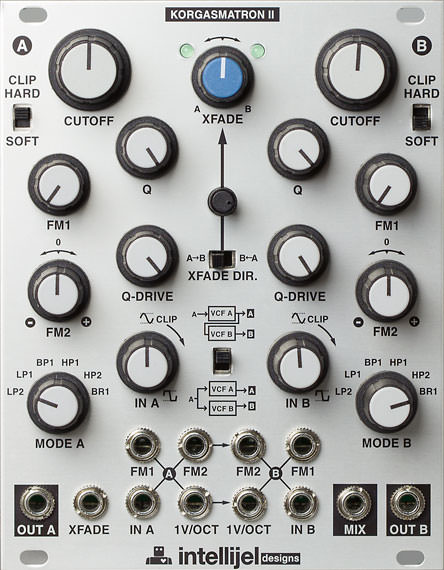
Dominic Butler of Factory Floor performing live at Tate Modern
Danjel van Tijn runs Intellijel Designs, one of a new breed of modular synth companies creating highly original, forward-thinking modules. For van Tijn, the urge to create something new was spurred by an early discovery of Richard D James: “When I was about 12 or 13 I started listening to a lot of electronic music, including AFX, and I heard all these wild stories about him building his own samplers and synths. It just seemed so impressive that not only was he making this incredible music but he was also creating his own unique tools to help do so.”
Years later, having enrolled in university to study electronic engineering with a view to pursuing a career in music technology, he realised that maybe he’d been misled all along. “Once I was in university and buried in what felt like purely theoretical studies I realised that AFX must have been exaggerating, because it was all way too complex – especially something like a sampler – to do on your own without a lot of disciplined study.”
Following his studies, van Tijn briefly worked for IVL, a company which manufactured products for Digitech and owned the Electrix and TC-Helicon brands. Returning to college to study recording, he spent a few years working in various music tech jobs. Like so many manufacturers, van Tijn began building modules for himself as a hobby, having been introduced to modulars by his friend (and future Intellijel employee) Haven Siguenza. “I really had no intention to start my own modular company. The first product I put out was supposed to be a DIY kit, but so many people wanted a fully built module instead of a kit that I had to look at ways to get things manufactured and ended up doing a small batch of proper modules. Eurorack really started to explode and things just seemed to really click for me. If you had asked me as a teenager what my dream job would be it would have been what I am doing now.”

Benefits of modular
The main appeal of modular synths to artists is obvious: their unrivalled flexibility makes them the most versatile form of synthesiser imaginable. Not happy with the tone of your filter? Change it for another one. Need more modulation sources? No problem – there are hundreds of different LFOs and envelope generators available and you can have as many as you like in one system.
What’s more easily overlooked is the way that modular equipment forces you to work differently to a traditional fixed-architecture synth. Of course, there are no presets; recalling all but the most basic patches is a laborious and inaccurate process. But more importantly there are implications for the way you use the synth, the way you make music and the results you get.
Amm suggests that this unique characteristic is one of the most appealing features of modulars: “I think that most, if not all, modular users enjoy the fact that the instrument is constantly challenging them to think about every aspect of the sound. That’s something you don’t get out of most self-contained synths, especially ones that have patch storage and presets.”
James Holden agrees: “Back when I was using modular software I came up with this method of making feedback systems – trying to breathe chaos and unpredictability into the instruments I built – and the modular is even more perfect for that. I use it alongside Max/MSP and Expert Sleepers’ CV plugins now so that the computer-modular system is just one thing, designed to be expressive like a real instrument – I learned violin so I want that experience of playing something unreliable and prone to unpleasant squeals and squeaks. Mostly Max For Live now handles generative and chance-based MIDI stuff, wonky sequencers and a few extra LFOs and envelopes. Everything else happens in the modular. My favourite modules are the Make Noise QMMG and a pair of Maths, by a long way, then I guess the Analogue Systems RS95E oscillators and the Metasonix tube bandpass are totally indispensable to me.
I want that experience of playing something unreliable and prone to unpleasant squeals and squeaks.
“Quite often I’m actually just patching a polysynth with one or two minor deliberate errors – wonky voice allocation or random cross-modulation.” But that shouldn’t be taken to mean that it’s a random process of taking wild shots in the dark until something works. “It usually starts from an idea of what I want to try rather than serendipitous experimentation,” he adds.


03.44 AM
Hell yes! Great article. Can’t wait for the doc.
08.40 PM
I am in the process of falling into the abyss. I fear it will be a magnificent obsession for me.
06.47 AM
Funny watched this movie on Netflix over a buddies house and seen myself in it, even one of the guys had same look as me. I can relate with fighting with the outside world to return to my modular cave. Haha
In fact it was all rocket science to my buddy, although to me everything these geeks and modular synth scientist said made sense.